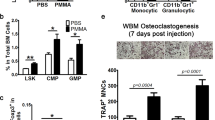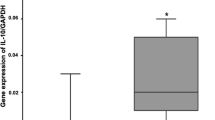Abstract
Purpose
Loosening of implants occurs mainly for two reasons: bacterial infection of the implant or “aseptic loosening” presumably due to wear particles derived from the implant. To gain further insight into the pathomechanism, we analysed activation of the T cell response in these patients.
Methods
Activation of peripheral T lymphocytes was determined by cytofluorometry as down-regulation of CD28 and up-regulation of CD11b. In addition, tissue samples obtained during surgery were analysed by quantitative RT-PCR for gene expression of CD3, CD14 and cathepsin K, as markers for T cells, monocytes/macrophages or osteoclasts, respectively.
Results
Activated T lymphocytes were detected in patients with infection but not in patients with aseptic loosening. Gene expression of CD3 was significantly enhanced in tissues of patients with infection compared to those with aseptic loosening. Expression of CD14 and of cathepsin K did not differ between the two groups.
Conclusion
Implant-associated infection and aseptic loosening are associated with a local inflammatory response, which eventually results in osteoclastogenesis and bone resorption. Systemic T cell activation, in contrast, occurs only in patients with implant-associated infection, and hence analysis of T cell activation markers could serve as a diagnostic tool to differentiate between the two entities.




Similar content being viewed by others
References
Lew DP, Waldvogel FA (2004) Osteomyelitis. Lancet 364(9431):369–379
Goodman SB (2007) Wear particles, periprosthetic osteolysis and the immune system. Biomaterials 28(34):5044–5048
Wooley PH, Schwarz EM (2004) Aseptic loosening. Gene Ther 11(4):402–407
Nelson CL, McLaren AC, McLaren SG, Johnson JW, Smeltzer MS (2005) Is aseptic loosening truly aseptic? Clin Orthop Relat Res 437:25–30
Drees P, Eckardt A, Gay RE, Gay S, Huber LC (2007) Mechanisms of disease: Molecular insights into aseptic loosening of orthopedic implants. Nat Clin Pract Rheumatol 3(3):165–171
Wagner C, Obst U, Hansch GM (2205) Implant-associated posttraumatic osteomyelitis: collateral damage by local host defense? Int J Artif Organs 28(11):1172–1180
Purdue PE, Koulouvaris P, Nestor B, Sculco T (2006) The central role of wear debris in periprosthetic osteolysis. HSS J 2(2):102–113
Abu-Amer Y, Darwech I, Clohisy JC (2007) Aseptic loosening of total joint replacements: mechanisms underlying osteolysis and potential therapies. Arthritis Res Ther 9(Suppl 1):S6
Granchi D, Ciapetti G, Stea S et al (1999) Cytokine release in mononuclear cells of patients with Co-Cr hip prosthesis. Biomaterials 20(12):1079–1086
Stea S, Visentin M, Granchi D et al (1999) Wear debris and cytokine production in the interface membrane of loosened prostheses. J Biomater Sci Polym Ed 10(2):247–257
Gaida MM, Mayer B, Stegmaier S, Schirmacher P, Wagner C, Hansch GM (2012) Polymorphonuclear neutrophils in osteomyelitis: link to osteoclast generation and bone resorption. Eur J Inflamm 10(3):413–426
Wagner C, Heck D, Lautenschlager K et al (2006) T lymphocytes in implant-associated posttraumatic osteomyelitis: Identification of cytotoxic T effector cells at the site of infection. Shock 25(3):241–246
Wagner C, Kotsougiani D, Pioch M, Prior B, Wentzensen A, Hansch GM (2008) T lymphocytes in acute bacterial infection: increased prevalence of CD11b(+) cells in the peripheral blood and recruitment to the infected site. Immunology 125(4):503–509
Kotsougiani D, Pioch M, Prior B, Heppert V, Hansch GM, Wagner C (2010) Activation of T lymphocytes in response to persistent bacterial infection: induction of CD11b and of Toll-like receptors on T cells. Int J Inflamm 2010:526740
Henderson B, Nair SP (2003) Hard labour: bacterial infection of the skeleton. Trends Microbiol 11(12):570–577
Wada T, Nakashima T, Hiroshi N, Penninger JM (2006) RANKL–RANK signaling in osteoclastogenesis and bone disease. Trends Mol Med 12(1):17–25
Leibbrandt A, Penninger JM (2008) RANK/RANKL: Regulators of immune responses and bone physiology. Ann NY Acad Sci 1143(1):123–150
Walsh NC, Crotti TN, Goldring SR, Gravallese EM (2005) Rheumatic diseases: the effects of inflammation on bone. Immunol Rev 208(1):228–251
Baldwin L, Flanagan BF, McLaughlin PJ, Parkinson RW, Hunt JA, Williams DF (2002) A study of tissue interface membranes from revision accord knee arthroplasty: the role of T lymphocytes. Biomaterials 23(14):3007–3014
Hallab NJ, Anderson S, Stafford T, Glant T, Jacobs JJ (2005) Lymphocyte responses in patients with total hip arthroplasty. J Orthop Res Off Publ Orthop Res Soc 23(2):384–391
Linsley PS, Ledbetter JA (1993) The role of the CD28 receptor during T cell responses to antigen. Annu Rev Immunol 11:191–212
Cocks BG, Chang C-CJ, Carballido JM, Yssel H, de Vries JE, Aversa G (1995) A novel receptor involved in T-cell activation. Nature 376(6537):260–263
Christensen JE, Andreasen SØ, Christensen JP, Thomsen AR (2001) CD11b expression as a marker to distinguish between recently activated effector CD8+ T cells and memory cells. Int Immunol 13(4):593–600
McFarland HI, Nahill SR, Maciaszek JW, Welsh RM (1992) CD11b (Mac-1): a marker for CD8+ cytotoxic T cell activation and memory in virus infection. J Immunol 149(4):1326–1333
Fiorentini S, Licenziati S, Alessandri G et al (2001) CD11b expression identifies CD8+CD28+ T lymphocytes with phenotype and function of both naive/memory and effector cells. J Immunol 166(2):900–907
Wagner C, Hänsch GM, Stegmaier S, Denefleh B, Hug F, Schoels M (2001) The complement receptor 3, CR3 (CD11b/CD18), on T lymphocytes: activation-dependent up-regulation and regulatory function. Eur J Immunol 31(4):1173–1180
Vallejo AN (2007) Immune remodeling: lessons from repertoire alterations during chronological aging and in immune-mediated disease. Trends Mol Med 13(3):94–102
Vallejo AN (2005) CD28 extinction in human T cells: altered functions and the program of T-cell senescence. Immunol Rev 205(1):158–169
Monteiro J, Batliwalla F, Ostrer H, Gregersen PK (1996) Shortened telomeres in clonally expanded CD28-CD8+ T cells imply a replicative history that is distinct from their CD28 + CD8+ counterparts. J Immunol 156(10):3587–3590
Griem P, Gleichmann E (1995) Metal ion induced autoimmunity. Curr Opin Immunol 7(6):831–838
Conflict of interest
The authors declare that they have no conflict of interest.
Author information
Authors and Affiliations
Corresponding author
Rights and permissions
About this article
Cite this article
Dapunt, U., Giese, T., Prior, B. et al. Infectious versus non-infectious loosening of implants: activation of T lymphocytes differentiates between the two entities. International Orthopaedics (SICOT) 38, 1291–1296 (2014). https://doi.org/10.1007/s00264-014-2310-5
Received:
Accepted:
Published:
Issue Date:
DOI: https://doi.org/10.1007/s00264-014-2310-5




